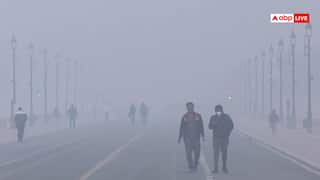Vulture Population In India Down By 99% Since 1980s, Conservationists Sound Alarm
Assistant Director of Bombay Natural History Society Sachin Ranade said in 1980s, there were nearly four crore vultures in India, but presently there are hardly four lakh vultures.

A decline of India's vulture population by a shocking 99 per cent since the 1980s has left conservationists and experts concerned. Conservationists said out of the five species recorded in the early 80s, only two existed.
Speaking to ABP Live, Assistant Director of Bombay Natural History Society Sachin Ranade said in 1980s, there were nearly four crore vultures in India, but presently there are hardly four lakh vultures.
"This means we have lost almost 99 per cent of the species. The main reason behind this is the usage of diclofenac drug which is widely used in veterinary treatments," Ranade said.
In March 2006, the Indian government announced a ban on the veterinary use of diclofenac.
"Notably, if the drug used in any animal dies, the drug remains in the liver and kidney of the animal. As vultures serve as scavengers of the environment, when they consume the flesh of the carcasses, the drug affects the vultures. In this way, the population is degrading," he further said.
Ranade further said that vultures maintain the ecological balance of the environment.
"It is evident that vultures and the environment are inseparable. Where on one hand, the world is advancing with science, and with innovations and creations of man along with the use of chemicals, it is also degrading the environment we live in, so it is also our sole responsibility to save the environment," he said.
Ranade said a vulture conservation breeding centre has been established in Rani area of Assam's Kamrup district where two breeds of vultures are conserved. "It has been noticed that a huge population of vultures have died in Assam due to poisoning. To prevent any such actions in future, awareness campaigns must be carried out," Ranade said.
The Indian vulture is native to India, Pakistan and Nepal. It has been listed as critically endangered on the International Union for Conservation of (IUCN) Red List since 2002.
There have been several instances of vultures dying after consuming carcasses of poisoned animals in Assam in the past few years. Experts said poisoning impacts 88 per cent of threatened vulture species.
On 24 February this year, six Himalayan Griffon vultures were found dead in a paddy field in Assam's Lakhimpur district. Two vultures were recovered by a team of forest officials from the site in a critical condition.
It was later found that the vultures died after consuming carcasses of cattle that were allegedly poisoned in the field.
Over 100 endangered vultures died in Assam's Chaygaon area due to suspected insecticide poisoning in March 2022. The incident took place after the birds consumed meat from the poisoned carcass of a dog. The vultures belonged to the Himalayan Griffon species, listed in Schedule 1 of the Wildlife Protection Act, 1972, as endangered species that need rigorous protection.
At least 56 vultures died in the state's Tinsukia district after consuming poisoned carcasses of cows between January and February 2021. Another 19 vultures had died in Sivasagar district after consuming meat of a dead cow while 39 vultures had died in the same district in March 2019.
Wildlife conservationist Mubina Akhtar said just like the 'Save Tiger' campaign, the government and Non-Governmental Organisations (NGO) should also lead a strong initiative to save the vultures from getting killed.
"Vultures are a very important part of the ecosystem as they serve as the scavengers who live on the carcasses of other animals and help in keeping the environment clean. The death of these vultures is having an adverse effect on the planet. It has been observed that the mortality rate is higher in rural areas due to the use of pesticides and insecticides and drugs used for stray dogs or jackals to save their poultries," Akhtar told ABP Live.
Akhtar also faulted ineffective awareness campaigns for the decline in vulture population. She said if the scavengers are endangered, then the rate of viral diseases and pandemics will increase in the environment.
"The social groups working for the conservation of these scavengers are inadequate with facilities. They should be helped and encouraged by the gram panchayats, civic bodies or the civic social groups in order to save their lives," she said.
"The groups must make the people aware of the specific month of November when the stray dogs, jackals or leopards opt for a high rate of hunting and prohibit them from using insecticides or pesticides," Akhtar further said.







































